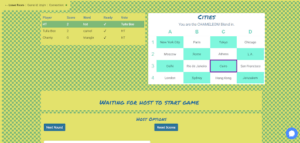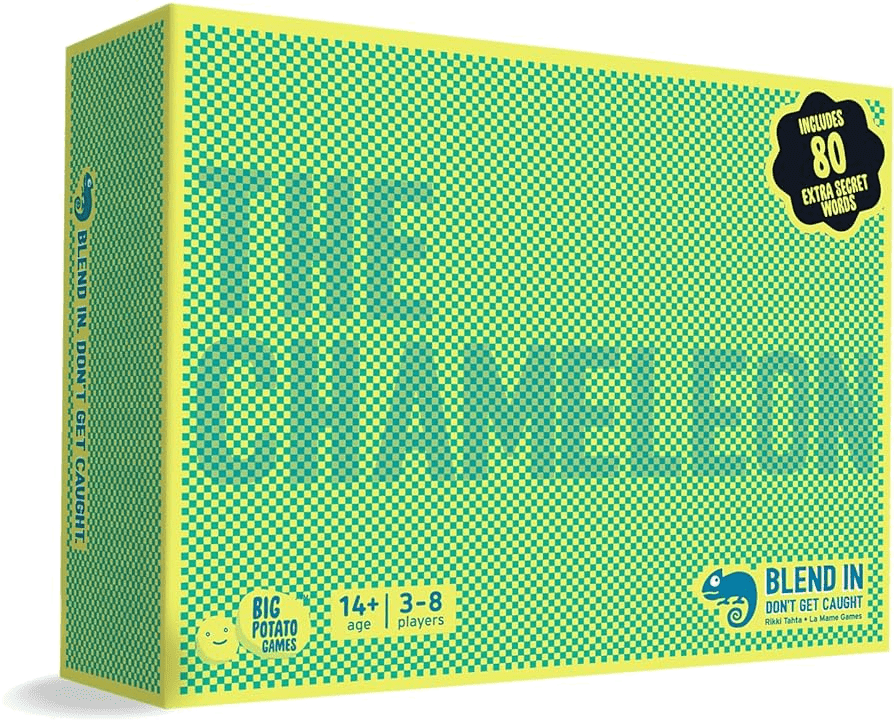For my critical play, I played “The Chameleon” online with two of my friends.

This is a social deduction game created by Rikki Tahta and published by Big Potato Games with a broad audience, including casual gamers, families, and friend groups. My team is creating a storytelling social deduction game where players determine who a spy is by figuring out what “missions” they have been assigned (ex. tap your pen on each of your turns, write at least one word that ends with an ‘s’ each turn). The Chameleon is also a game where you try to determine the spy, but in that game, you do so by figuring out who does not know the word that has been chosen from a grouping of similar words.
While “The Chameleon” and our storytelling spy game diverge in theme and mechanics, they both offer compelling social interactions and opportunities for deception. Where “The Chameleon” focuses on deduction and bluffing within a single round, our game extends the tension across multiple rounds, weaving a narrative arc into the gameplay.
“The Chameleon” excels in its simplicity and accessibility. With minimal setup and easy-to-understand rules, players can jump into the action swiftly. However, its single-round format may limit long-term engagement for some players, as the game’s replayability hinges on the group’s ability to maintain interest in repeated rounds. In addition, the simplicity of the gameplay sometimes took away some of the difficulty while my friends and I played it. While playing, I felt that the rounds tended to be too easy without many opportunities for intrigue. We played 5 rounds and guessed the chameleon in four of the five rounds, with the chameleon guessing the word we described in the other round.
In contrast, our storytelling spy game introduces a narrative element that adds depth and immersion. By tasking players with completing a story while a spy disrupts their progress or while they have to pay attention to a potential spy’s actions, we create a dynamic environment where storytelling converges with strategic gameplay. This integration of theme and mechanics fosters a richer experience, allowing players to become more invested in the outcome of each round.
Furthermore, our game encourages creative problem-solving as players navigate the challenges presented by the spy’s covert actions. From subtle gestures to strategic interruptions, the spy must carefully manipulate the narrative without arousing suspicion. This aspect of asymmetric gameplay adds layers of complexity and intrigue, enhancing replayability and fostering emergent storytelling moments.
However, both games could benefit from refining their pacing to maintain momentum throughout the gameplay experience. In “The Chameleon,” a timer ensures brisk rounds, but it may also lead to rushed decisions and missed opportunities for deeper strategy.

In the one case where the chameleon (me) was not guessed, the clues given were not vague enough to make guessing difficult. Similarly, our storytelling spy game requires careful balancing to prevent rounds from dragging on or feeling too chaotic.
Drawing from formal elements and the Mechanics-Dynamics-Aesthetics (MDA) framework, we recognize the importance of player engagement and emergent gameplay experiences. By integrating thematic elements into our mechanics, we aim to create a cohesive and immersive player experience that resonates beyond the tabletop.
Furthermore, our analysis underscores the significance of player agency and meaningful choices in game design. Whether through deductive reasoning in “The Chameleon” or strategic manipulation in our storytelling spy game, players crave opportunities to shape the outcome of the game and leave their mark on the narrative.
In conclusion, while “The Chameleon” and our storytelling spy game offer distinct gameplay experiences, they share a common goal of fostering social interaction and strategic thinking. By analyzing their strengths and weaknesses, we gain valuable insights into the nuances of game design and the importance of player engagement. As we continue to refine our own game concept, we draw inspiration from these experiences to craft an immersive and memorable tabletop experience for players of all ages.




